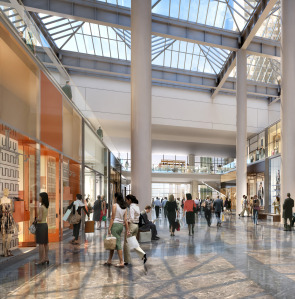By Al Barbarino Commercial Observer

(An interior rendering of the retail space slated for Brookfield Place)
Burberry. Salvatore Ferragamo. Ermenegildo Zegna. Michael Kors. Scoop. Hermes. Judith & Charles. Calypso St. Barth.
It’s an impressive list of retailers. What’s more striking is that Brookfield Office Properties cut deals with all of them this year, and they’ll be sharing a home at the revamped Brookfield Place beginning next year, forming an unprecedented shopping destination Downtown.
“These spaces will flow like they never did before,” said Ed Hogan, the firm’s leasing director, as he shuffled through a sawdust-laden floor in a towering interior space that will become a two-floor haven for the elite lineup.
But it’s no mall. Upon completion, Brookfield Place will feel more like a neighborhood, Mr. Hogan said. He walks to the west-facing edge of the space and lifts a curtain covering a large exterior window, pointing eagerly to a waterfront plaza along the Hudson River that will become a 10,000-square-foot outdoor dining area for Le District, a French eatery.
One day soon, as they did long ago, Mr. Hogan envisions barges pulling up to the harbor, hauling fresh produce for use within Le District, which will feature a 25,000-square-foot indoor marketplace that, with its various chef-inspired dining options, could ultimately be viewed as Downtown’s response to Eataly.
Underneath its eight million square feet of office space, and in addition to its high-end dealers, which often find comfort in numbers, Brookfield Place will include a long list of quick-service eateries, sit-down dining options and a 35,000-square-foot Equinox gym.
Italian menswear store Ermenegildo Zegna was the latest of the high-end shops to join, signing a 10-year, 3,550-square-foot deal for a two-story store that will feature a 40-foot-tall glass façade on the north side of a new glass-cube atrium entrance on West Street, which will provide street and underground access to the World Trade Center.
When the retail complex reopens in the fall of 2014, after the completion of a $250 million renovation that repurposes its 250,000 square feet of space, it will give rise to a retail lineup that may never have seemed viable—if even imaginable—at any point in Downtown’s history.
“The names on that list would never have come Downtown 10 years ago,” said Brookfield’s David Cheikin, who heads up the firm’s Lower Manhattan strategy.
But some hope that with the rise of Brookfield Place’s new lineup—as well as the retail slated for the new World Trade Center site, where Westfield is rumored to be in talks with its own share of luxury retailers—more high-end brands will flow into Downtown’s other corridors, which are already seeing rent increases and high demand.
That growth has been pushed along by the ongoing rebirth of Downtown, where millions of square feet of new commercial space is coming online, tourism continues to boom and a new demographic of New Yorker moves in, amid a population that has doubled over the last decade to 60,000. Also, the new Calatrava and Fulton transportation hubs have emerged as a critical support for the growth.
“Luxury’s time has come in Lower Manhattan,” said Alan Schmerzler, an executive director of retail services with Cushman & Wakefield. “There’s a young, sophisticated, educated and well-paid demographic, so there’s justification and rationale for luxury.”
Data from Downtown Alliance shows that of Lower Manhattan’s more than 60,000 residents living in 31,000 housing units, 26 percent are single adults with an average annual income of $130,000, 33 percent are young couples with a household income of $228,000, and families, which represent 27 percent, have a household income of $252,000.
Tourism, another major boon, is on pace to log another record-breaking year after 52 million visitors helped to create $55.3 billion in economic impact last year. Data from the Downtown Alliance shows in 2002 there were just four million visitors to Lower Manhattan’s events, museums and attractions, but by last year the number of unique visitors to the submarket had risen to 11.5 million, helped in no small part by the success of the 9/11 Memorial as a new tourist destination.
The office market is keeping pace, as the older building stock is more than ever sought as a value alternative to Midtown South and as new Class A products rivals those seen uptown. The market recorded nearly one million square feet of positive absorption in the third quarter, as Downtown shaped up as viable alternative for the next wave of tech and creative companies, particularly after the groundbreaking entry of big-timer Conde Naste, which will anchor One World Trade Center.

